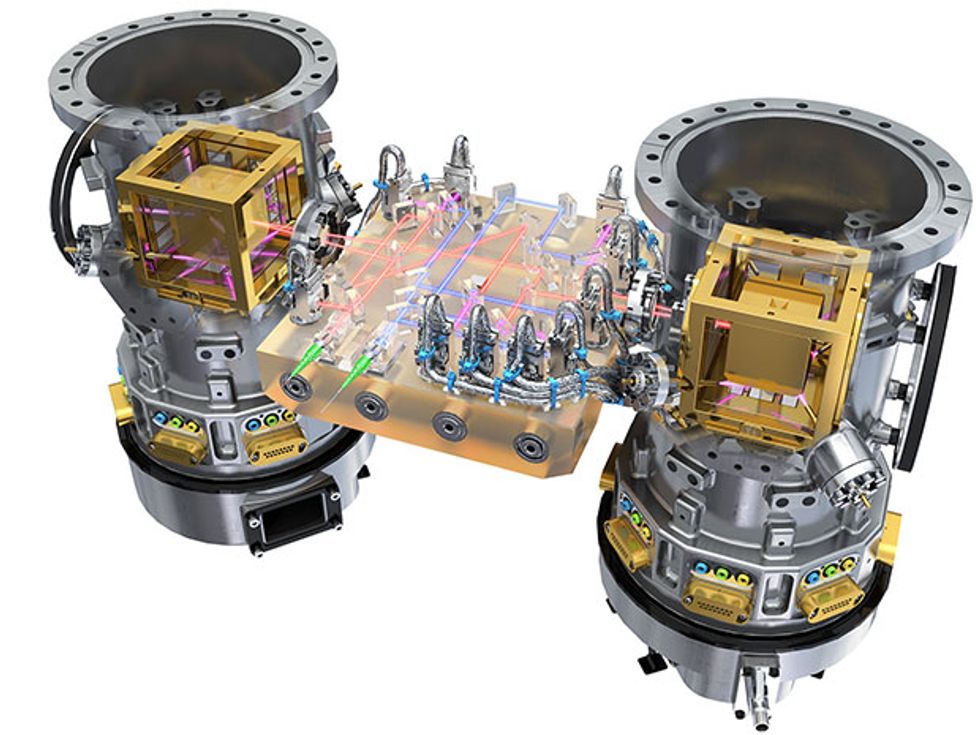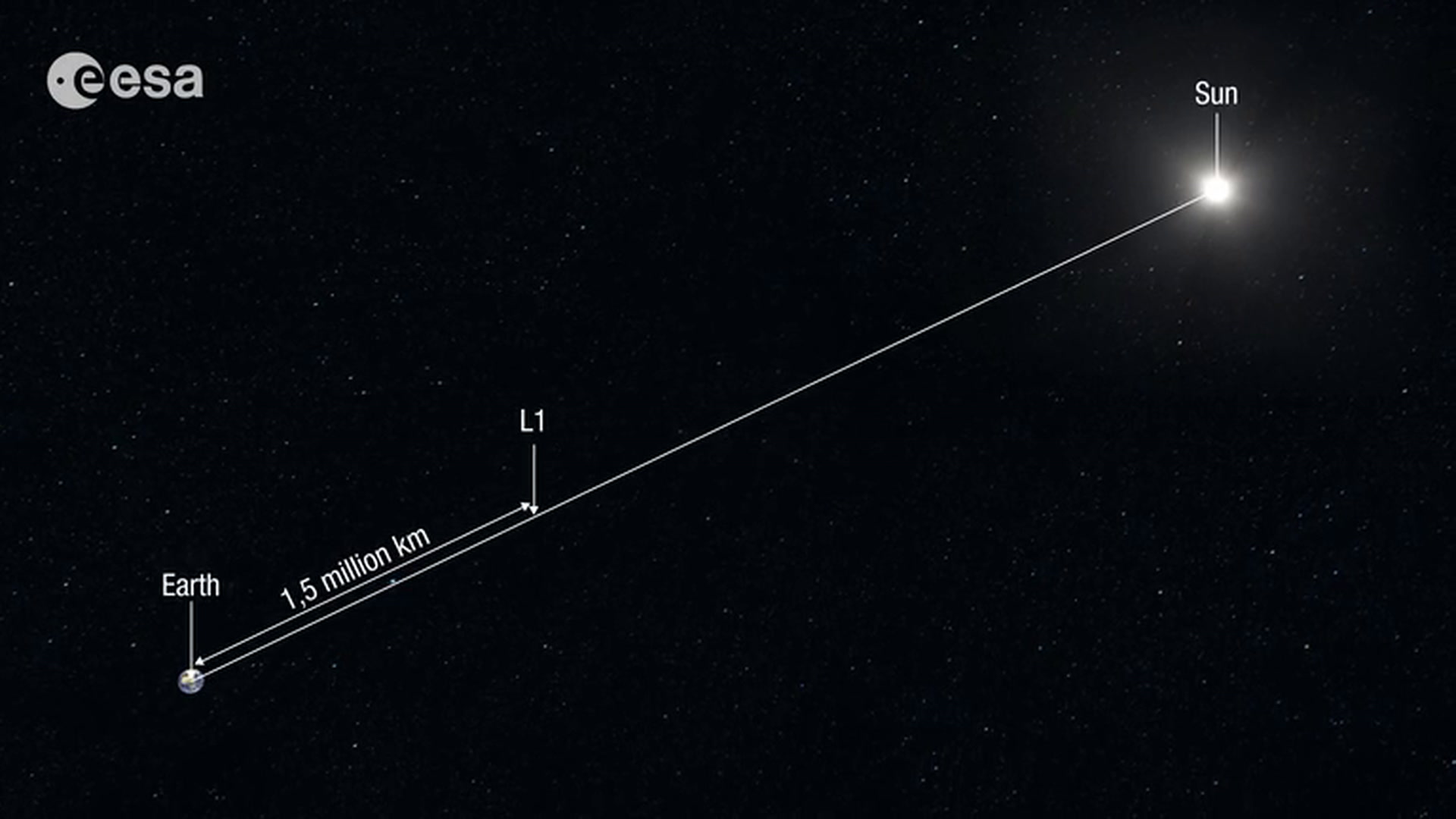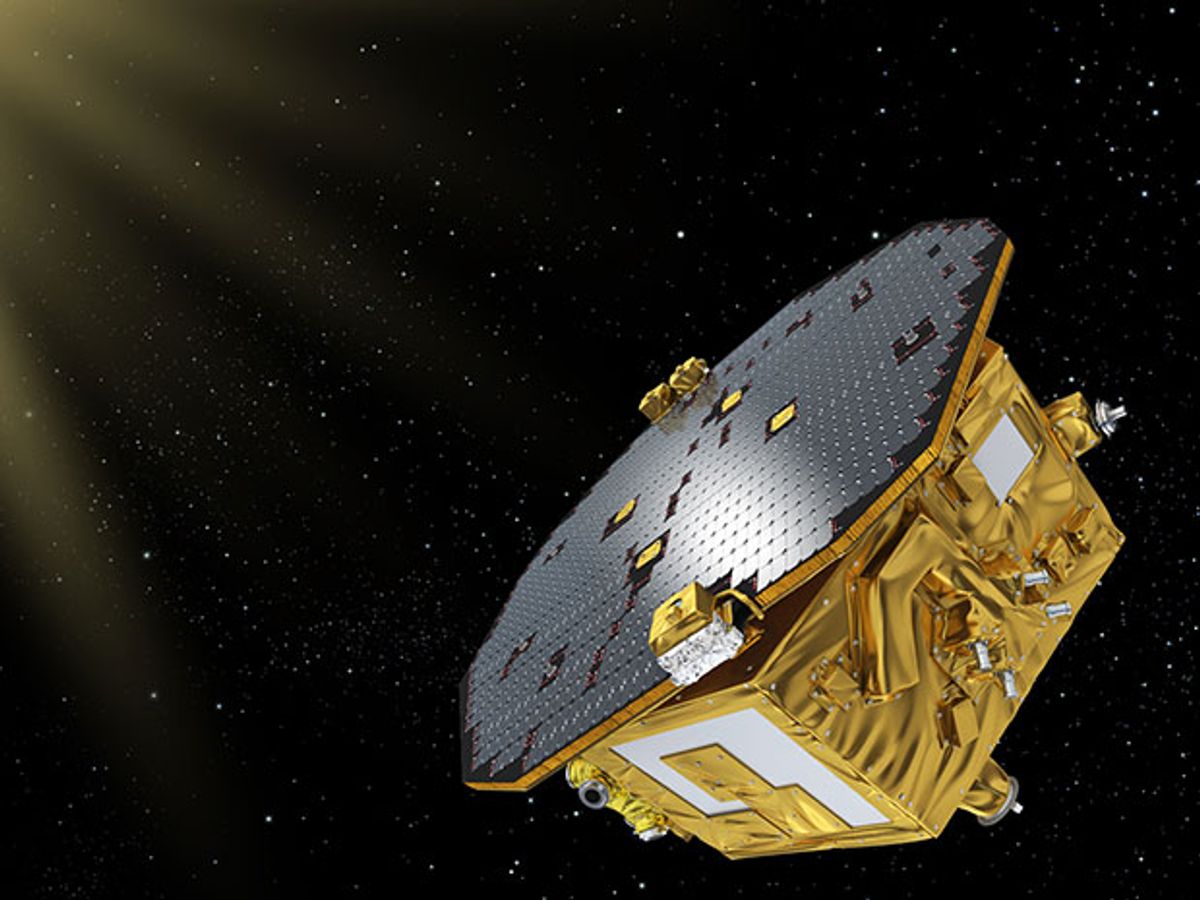A diffuse clutch of spacecraft fly through space, connected only by the laser beams that register tiny changes in position across the millions of kilometers that separate them.
This basic vision for a space-based gravitational wave observatory, which those planning a European mission generally call the Laser Interferometer Space Antenna (LISA), is about 30 years old. And it could be 20 years more before we see it in action. But results released today by the European Space Agency’s LISA Pathfinder team suggest it’s possible to achieve the sensitivity needed to build it. Such a space-based observatory would use a technique similar to its Earth-bound cousin LIGO—which announced the first direct detection of gravitational waves earlier this year—to detect slight ripples in the fabric of space-time. But the quarry would be gravitational waves in a frequency range that’s inaccessible here on Earth, one that includes sources such as merging supermassive black holes in the heart of colliding galaxies.

LISA Pathfinder, which launched late last year, contains a small pair of gold-platinum “test masses” and a laser interferometer to measure changes in the distance between them. The mission, a shrunken-down version of what in LISA would be an “arm” made by two spacecraft, isn’t designed to detect gravitational waves. Instead, it’s intended to test out some of the basic technologies required to do so and show that a spacecraft can have low enough noise to be sensitive to passing gravitational waves. A big part of that is creating an environment where the test masses are in near-perfect free fall, protected from the confounding nudges of forces other than gravity and floating free of the rest of the spacecraft.
The results, published today in Physical Review Letters, indicate that LISA Pathfinder exceeded its requirements. At the frequencies gravitational wave scientists are interested in, the spacecraft can discern an acceleration between the test masses of less than a femto-g, or one millionth of a billionth of the acceleration due to gravity on the surface of the Earth. Says principal investigator Stefano Vitale: “The closest thing to a force on the test masses corresponding to a femto-g is the weight a bacterium in your hand.”
“This paper is a green light for LISA,” adds Vitale, a professor at the University of Trento in Italy. “For us it’s an enormous sense of achievement."
The results must also be an enormous relief for Vitali and his colleagues. The LISA Pathfinder mission was originally set to fly in 2006, but it ran into technical hurdles. “There were a number of technologies that appeared to be relatively easy [that] turned out to be significantly more challenging once people got into it,” says Fabio Favata, who coordinates the science program at the European Space Agency. The team had to change direction when it came to the thrusters in the spacecraft’s micro-propulsion system, Favata says. These are used to gently reposition the spacecraft, a key technology needed to make sure the test masses never come in physical contact with the surrounding spacecraft. The caging mechanism, which secures the test masses during launch so they don’t rattle around like a bowling ball in a washing machine—and then gently releases them—also proved a challenge.
In the end, it all came together. The test masses, the team says, have achieved a new record for free fall. Accounting for and curbing the many non-gravitational phenomena that could perturb the masses and swamp a gravitational wave signal was no easy task. Housed inside the spacecraft, the test masses are protected from the pressure of solar radiation. But other potential sources of acceleration remain. Magnetic fields can have an effect. So, too, can the buildup of charge on the test masses created when cosmic rays pass through the shielding of the spacecraft, as well as the collision of residual gas molecules. “Our error budget is a book,” Vitale says.
System engineering is critical for this sort of experiment, Vitale adds. The mass in LISA Pathfinder, for example, had to be carefully distributed to prevent the spacecraft’s own gravity from preferentially pulling the test masses in any particular direction. “This is a single flying instrument,” he says. “It’s not a satellite carrying an instrument. The entire system is an instrument.”

“The results reported by the [LISA Pathfinder] team are, quite simply, a tour de force in precision measurement,” David Reitze, the executive director of LIGO, wrote in a commentary accompanying the team’s results, which were published on Tuesday in Physical Review Letters. “These results bode extremely well for the future LISA mission.”
The exact shape of that mission is still up in the air, says ESA’s Fabio Favata. There is a plan in place to launch a gravitational wave detecting mission in 2034, he explains, but the exact specifications have yet to be decided. Favata says the plan is to issue a call for mission proposals soon, perhaps later this year. A report (pdf) issued earlier this year by the curiously acronymed Gravitational Observatory Advisory Team (GOAT) recommended using laser interferometry (the technology used by LIGO that has long been on the table for a space mission) for the 2030s mission.
But a good amount of technology development still needs to be done, Favata says. In particular, he cites the laser systems and the telescopes that would be used to aim those lasers across the millions of kilometers between spacecraft. The GOAT group said that much of the technology development that needs to happen isn’t dependent on the particulars of the laser interferometry mission. “This allows us to begin technology development in advance of the mission concept,” says Favata. That work, he adds, has already begun.
Rachel Courtland, an unabashed astronomy aficionado, is a former senior associate editor at Spectrum. She now works in the editorial department at Nature. At Spectrum, she wrote about a variety of engineering efforts, including the quest for energy-producing fusion at the National Ignition Facility and the hunt for dark matter using an ultraquiet radio receiver. In 2014, she received a Neal Award for her feature on shrinking transistors and how the semiconductor industry talks about the challenge.



